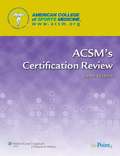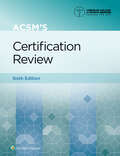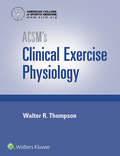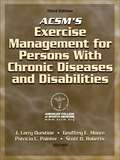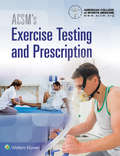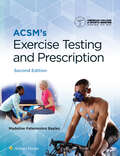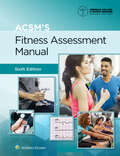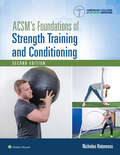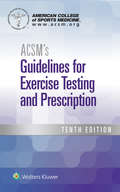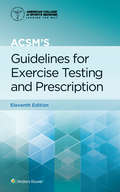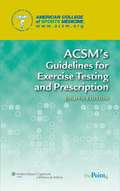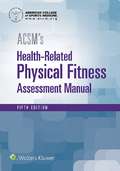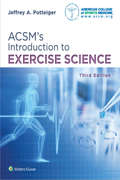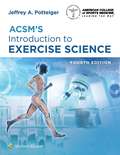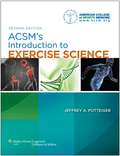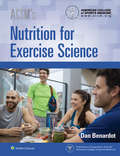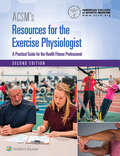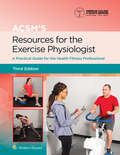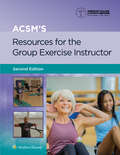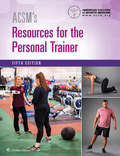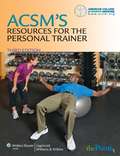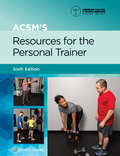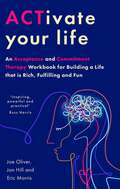- Table View
- List View
ACSM's Certification Review (3rd edition)
by Khalid W. Bibi Michael G. NiederpruemACSM's Certification Review is a review manual for candidates wanting an ACSM credential including ACSM Certified Health Fitness Specialist (HFS), the ACSM Clinical Exercise Specialist (CES), and the ACSM Certified Personal Trainer (CPT) certifications. Content is based on the Knowledge, Skills, and Abilities (KSAs) found in ACSM's Guidelines for Exercise Testing and Prescription.
ACSM's Certification Review (American College of Sports Medicine)
by American College of Sports Medicine Pete MagyariReflecting the authoritative expertise of the American College of Sports Medicine, ACSM’s Certification Review, 6th Edition, prepares users to successfully pass certification exams and become an ACSM Certified Personal trainer (ACSM-CPT), ACSM Certified Exercise Physiologist (ACSM-EP), or ACSM Certified Clinical Exercise Physiologist (ACSM- CEP). This easy-to-use review combines career-specific information with assessment tools and application-based exercises to boost test-taking confidence and help users ensure a seamless transition to practice. Content in this 6th Edition has been updated to align with the latest edition of ACSM’sGuidelines for Exercise Testing and Prescription and reorganized to strengthen connections between the material users will encounter on their exams and how they will apply that knowledge in practice.
ACSM's Clinical Exercise Physiology
by Walter R. Thompson Cemal OzemekReflecting the unsurpassed quality and excellence synonymous with the American College of Sports Medicine, ACSM’s Clinical Exercise Physiology, second edition, provides an evidence-based approach to exercise as intervention for more than 35 conditions commonly encountered in practice — from a host of cardiovascular disorders to immunological/hematological disorders. Condition chapters are logically organized by disease types and divided into sections that cover specific conditions from a pathological and etiological perspective, with additional coverage of important considerations and foundational elements — such as screening, pharmacology, and electrocardiography — ensuring a complete view of clinical exercise physiology. Fully aligned with ACSM’s Guidelines for Exercise Testing and Prescription, 11th Edition, and updated throughout with new content and learning tools, this second edition provides total support for success in advanced undergraduate or graduate clinical exercise physiology courses, as well as the ACSM’s Clinical Exercise Physiology certification exam.
ACSM's Clinical Exercise Physiology: Musculoskeletal, Neuromuscular, Neoplastic, Immunologic And Hematologic Conditions
by American College of Sports MedicineACSM’s Clinical Exercise Physiology adapts and expands upon the disease-related content from ACSM’s Resource Manual for Guidelines for Exercise Testing and Prescription, 7th Edition, to create a true classroom textbook. This new resource offers research-based coverage of more than 35 conditions commonly seen in practice—from a host of cardiovascular disorders to immunological/hematological disorders. Condition chapters are organized by disease types and then divided into sections that cover specific conditions from a pathological and etiological perspective. To provide a complete view of clinical exercise physiology, the book also covers important considerations and foundational elements, such as screening, pharmacology, and electrocardiography. As an American College of Sports Medicine publication, the text offers the unsurpassed quality and excellence that has become synonymous with titles by the leading exercise science organization in the world.
ACSM's Exercise Management For Persons With Chronic Diseases And Disabilities (3rd Edition)
by Geoffrey Moore Scott Roberts American College of Sports Medicine Staff J. Larry Durstine Patricia S. PainterNow in its third edition, ACSM's Exercise Management for Persons With Chronic Diseases and Disabilities offers both exercise and health professionals the latest research and applications for integrating exercise into the treatment of 49 chronic diseases and disabilities. This reference was developed by the American College of Sports Medicine (ACSM) and written by contributors with significant clinical and research experience in exercise programming for people with chronic conditions. ACSM's Exercise Management for Persons With Chronic Diseases and Disabilities, Third Edition,contains tools to assist in the coordination of exercise within an integrated model of patient care. The updated edition presents a framework for determining functional capacity in persons with chronic diseases and disabilities and offers guidance in developing appropriate exercise programming to optimize functional capacity and reduce the compounding effects of exercise intolerance. Unlike textbooks on special populations, ACSM's Exercise Management for Persons With Chronic Diseases and Disabilities provides an overview of exercise management and addresses a wider spectrum of chronic diseases and disabilities. A consistent and concise format allows readers quick access to the pathology of interest, training and response to exercise, management of medications, and recommendations and special considerations of exercise testing and programming. Within the text, diseases and disorders are organized into six sections: cardiovascular; pulmonary; metabolic; orthopedic; neuromuscular; and cognitive, psychological, and sensory. Information presented for each of the 49 conditions is based on the most current clinical research. The third edition includes an added color and contains new chapters on metabolic syndrome, stress and neuropsychiatric disorders, multiple chronic conditions, and fibromyalgia. Information on professional preparation in serving patients with chronic diseases or disabilities has also been added. In addition, reformatted tables provide quicker reference for testing and prescription data. Recommended readings found at the end of the book offer resources for more in-depth study. The text also includes case studies for each condition. These cases, drawn from the contributor's clinical practice, illustrate how scientific research and clinical experience can combine in the development of an informed program of care for each patient. Case studies follow a set format, beginning with an overview and a subjective objective assessment plan (SOAP) report, followed by an exercise program and a follow-up statement for select cases. ACSM's Exercise Management for Persons With Chronic Diseases and Disabilities, Third Edition,presents exercise as a viable component in the care and treatment of chronic disease and disability and offers guidance for appropriate exercise prescription that can positively affect functional capacity and slow or prevent exercise intolerance. As the prescription of exercise for persons with chronic conditions increases, exercise and health professionals require the appropriate data and tools to serve these individuals. ACSM's Exercise Management for Persons With Chronic Diseases and Disabilities will assist professionals in translating the science of exercise physiology into the art of practicing exercise medicine.
ACSM's Exercise Testing and Prescription
by American College of Sports MedicineACSM’SExercise Testing and Prescription adapts and expands upon the assessment and exercise prescription-related content from ACSM’s Resource Manual for Guidelines for Exercise Testing and Prescription, 7th Edition, to create a true classroom resource. Fully aligned with the latest edition of ACSM’s flagship title, ACSM’s Guidelines for Exercise Testing and Prescription, this practical resource walks students through the process of selecting and administering fitness assessments, using Guidelines to interpret results, and drafting an exercise prescription that is in line with Guidelines parameters. Designed for today’s learners, the text is written in a clear, concise style, and enriched by visuals that promote student engagement. As an American College of Sports Medicine publication, the book offers the unsurpassed quality and excellence that has become synonymous with titles by the leading exercise science organization in the world.
ACSM's Exercise Testing and Prescription (American College of Sports Medicine)
by Madeline Paternostro BaylesFully aligned with the latest edition of ACSM’s Guidelines for Exercise Testing and Prescription, ACSM’s Exercise Testing and Prescription, 2nd Edition, equips students and practitioners to confidently collect, interpret, and act upon physical fitness data for healthy and special populations. Reflecting the unsurpassed expertise of the American College of Sports Medicine, this practical text walks users through the process of selecting and administering fitness assessment, interpreting results, and drafting exercise prescriptions in line with proven Guidelines parameters. The updated 2nd Edition is optimized for today’s learners, combining clear, concise writing with dynamic visuals to keep readers engaged, clarify essential concepts and practices, and prepare users for confident clinical practice.
ACSM's Fitness Assessment Manual
by American College of Sports MedicinePublished by the American College of Sports Medicine, ACSM's Fitness Assessment Manual builds on the standards established in ACSM’S Guidelines for Exercise Testing and Prescription, 11th Edition. With a focus on assessment, this new 6th edition is organized by component of fitness: body composition, cardiorespiratory fitness, muscular fitness, flexibility; and by type of testing: maximal and submaximal exercise testing, ECG, and metabolic calculations. Updated coverage throughout in a user-friendly format, makes this an essential resource for those studying to enter the fitness and rehabilitation fields, as well as those already working who need to align their practice to industry standards.
ACSM's Foundations of Strength Training and Conditioning (American College of Sports Medicine)
by Nicholas RatamessDeveloped by the American College of Sports Medicine (ACSM), ACSM’s Foundations of Strength Training and Conditioningoffers a comprehensive introduction to the basics of strength training and conditioning. This updated 2nd edition focuses on practical applications, empowering students and practitioners to develop, implement, and assess the results of training programs that are designed to optimize strength, power, and athletic performance. Clear, straightforward writing helps students master new concepts with ease, and engaging learning features throughout the text provide the understanding and confidence to apply lessons to clinical practice.
ACSM's Guidelines for Exercise Testing and Prescription
by American College of Sports MedicineThe tenth edition reflects some crucial and exciting changes, making the content necessary for effective study and practice. New pre-exercise health screening recommendations are critical to helping more of the population begin a safe, healthy physical activity program without consulting a physician. New and expanded information on the risks of sedentary behavior, clinical exercise testing and interpretation, high intensity interval training, musculoskeletal injury risk, fitness testing protocols and norms, and an expansion of the principles of health behavior change are included. Additionally, significant reorganization of content will help you reach the information you need quickly. This manual is an essential resource for all exercise professionals, as well as other health professionals who may council patients on exercise including physicians, nurses, physician’s assistants, physical and occupational therapists, dieticians, and health care administrators.
ACSM's Guidelines for Exercise Testing and Prescription
by American College of Sports Medicine Gary LiguoriThe flagship title from the prestigious American College of Sports Medicine, this critical handbook delivers scientifically based, evidence-informed standards to prepare you for success. Providing succinct summaries of recommended procedures for exercise testing and exercise prescription in healthy and diseased patients, this trusted manual is an essential resource for all exercise professionals, as well as other health professionals who may counsel patients on exercise including physicians, nurses, physician’s assistants, physical and occupational therapists, dieticians, and health care administrators. The extensively updated eleventh edition has been reorganized for greater clarity and integrates the latest Physical Activity Guidelines for Americans.
ACSM's Guidelines for Exercise Testing and Prescription (8th edition)
by Walter R. Thompson Neil F. Gordon Linda S. PescatelloThe single most internationally read and referenced text in sports medicine, exercise science, and health and fitness, this manual succinctly summarizes recommended procedures for exercise testing and exercise prescription in healthy and diseased individuals. This gold-standard text is a convenient, one-stop resource for the knowledge, skills, and abilities (KSAS) that must be mastered by candidates for all ACSM certifications. Written by international experts in numerous fields, the Eighth Edition is fully compatible with newly released physical activity guidelines from the United States Department of Health and Human Services and state-of-the-art, research-based recommendations. A companion Website for instructors will offer a test generator, an image bank, PowerPoint slides, and a Web CT/Black Board-Ready Course Cartridge. A student Website will offer the fully searchable text.
ACSM's Health-Related Physical Fitness Assessment
by American College of Sports MedicinePublished by the American College of Sports Medicine, this authoritative manual teaches health fitness professionals and students how to appropriately conduct fitness assessment testing. The focus on assessment makes this content critical for those studying to enter the fitness and rehabilitation fields, as well as those already working who need to align their practice to industry standards. This new edition has been fully updated to reflect key changes from the tenth edition of the ACSM’s Guidelines for Exercise Testing and Prescription. The goal of this Fifth Edition of ACSM’s Health-Related Physical Fitness Manual is to provide a comprehensive overview of why and how to perform assessments of the five health-related components of physical fitness, namely body composition, muscular strength, muscular endurance, flexibility, and cardiorespiratory fitness.
ACSM's Introduction to Exercise Science
by Jeff PotteigerThe only book to focus specifically on exercise science and the range of career paths in the field, ACSM’s Introduction to Exercise Science, 3rd Edition provides an engaging overview of exercise science and related concepts. Updated throughout to reflect the most current trends and theories in the field, this edition offers a new chapter on research and new online videos. In every chapter, leaders in the field share their stories and illustrate the importance and clinical relevance of core disciplines. Fascinating interviews and online video profiles and fieldtrips give students an insider’s view of the wide range of careers possible with an exercise science degree. As an American College of Sports Medicine publication, this full-color book offers the unsurpassed quality and excellence that has become synonymous with titles by the leading exercise science and sports medicine organization in the world.
ACSM's Introduction to Exercise Science
by Jeff PotteigerPresenting an engaging, up-to-date overview of exercise science and its related fields, ACSM’s Introduction to Exercise Science, 4th Edition, guides students to success throughout their courses and delivers a robust exploration of potential careers for today’s exercise science professionals. This full-color resource combines a succinct, accessible approach with the proven expertise of the American College of Sports Medicine — the leading authority in exercise science and sports medicine — to establish a practical understanding of how human movement assists individuals in their pursuit of good health, appropriate levels of physical activity and exercise, and successful sport and athletic performance. Each chapter illustrates the importance and practical relevance of key topics and provides an insider’s view of the profession through fascinating interviews and online video profiles and field trips. Updated to meet the needs of today’s emerging professionals, this 4th Edition incorporates new resources that emphasize application and help students make a confident transition to practice.
ACSM's Introduction to Exercise Science
by Jeffrey A. PotteigerThe book provides an overview of the components important to developing a solid understanding and appreciation of all aspects of exercise science.
ACSM's Nutrition for Exercise Science
by American College of Sports Medicine Dan BenardotPublisher's Note: Products purchased from 3rd Party sellers are not guaranteed by the Publisher for quality, authenticity, or access to any online entitlements included with the product. New from the American College of Sports Medicine! This clear and highly applied overview of exercise nutrition illustrates difficult concepts using real-world examples and case studies that allow students to put learning into practice. Well-known author Dan Benardot draws on his vast experience as an instructor, scientist, and practitioner to craft an engaging and factual resource that makes the nutrition of exercise science accessible. Written at a level appropriate for both exercise science majors and non-majors, this practical book is packed with helpful in-text learning aids and stunning visuals that bring concepts to life. As an ACSM publication, this text offers the unsurpassed quality and excellence that has become synonymous with titles by the leading exercise science organization in the world.
ACSM's Resources for the Exercise Physiologist
by American College of Sports MedicinePublished by the American College of Sports Medicine, this new edition is essential for certification candidates and practicing Exercise Physiologists. As the official preparation book for the ACSM Certified Exercise Physiologist examination, the title will guide those seeking certification as they prepare to sit for the exam. For those already practicing, this evidence-based resource will aid in providing the most current, competent guidance to clients. Now fully aligned with the tenth edition of ACSM’s Guidelines for Exercise Testing and Prescription, this second edition is reflective of the most current standards in the field. These updates include moving to the new pre-participation guidelines, which represent an important and significant change in the prescription of an exercise program. Incorporating ACSM's Exercise is Medicine® global health initiative throughout this text prepares the EP-C to become uniquely qualified to work with medical professionals to ensure that all patients and clients are participating in a physical activity program. Organized around the scope of ACSM EP-C practice domains, ACSM's Resources for the Exercise Physiologist includes an introductory section focusing on understanding exercise, physical activity, and pre-exercise screening. Coverage of assessment and programming for both healthy and special populations and extensive content about behavior change allows the EP-C to provide program options for varying types of clients. Finally, this text covers the ethics, legal issues, and business of fitness management.
ACSM's Resources for the Exercise Physiologist (American College of Sports Medicine)
by American College of Sports Medicine Benjamin GordonAn essential preparation book for the ACSM Certified Exercise Physiologist examination, ACSM’s Resources for the Exercise Physiologist, 3rd Edition, is an essential volume for certification candidates and practicing Exercise Physiologists looking to boost their exam confidence and achieve success in practice. This updated edition is fully aligned with the eleventh edition of ACSM’s Guidelines for Exercise Testing and Prescription and reflects the most current standards and practices in exercise physiology. Published by the American College of Sports Medicine, this practical resource is organized around the scope of ACSM-EP practice domains. A clear introduction to understanding exercise, physical activity, and pre-exercise screening opens the book, followed by thorough coverage of assessment and programming for healthy populations, assessment and programming for special populations, counseling and behavioral strategies for encouraging exercises, and legal, management and professional issues relevant to practice.
ACSM's Resources for the Group Exercise Instructor
by American College of Sports MedicineACSM’s Resources for the Group Exercise Instructor, 2nd Edition, equips fitness professionals with the knowledge and the skills needed to effectively lead group exercise in gyms, studios, recreational facilities, and clubs. An essential resource for undergraduate exercise science programs, students in pre-professional programs, and those independently prepping for the ACSM-GEI certification, this engaging, accessible text reflects the authoritative expertise of the American College of Sports Medicine (ACSM) and delivers complete preparation for becoming an ACSM Certified Group Exercise Instructor. The extensively revised and reorganized 2nd Edition streamlines learning and aligns content to the domains of the ACSM Certified Group Exercise Instructor Exam, boosting exam confidence and delivering step-by-step guidance to ensure success in professional practice.
ACSM's Resources for the Personal Trainer
by American College of Sports MedicinePublished by the American College of Sports Medicine, this Fifth Edition of ACSM’s Resources for the Personal Trainer is the critical content for those seeking to gain ACSM’s Certified Personal Trainer certification, and those currently practicing. This title is now fully aligned to the tenth edition of ACSM’s Guidelines for Exercise Testing and Prescription, and includes the new pre-participation guidelines, which will be critical for those in the personal trainer field. This title continues to recognize the Personal Trainer as a professional in the continuum of creating healthy lifestyles and provides the Personal Trainer with both the tools and scientific evidence to build safe and effective exercise programs for a variety of clients. ACSM’s Resources for the Personal Trainer is the official preparation book for the ACSM Certified Personal TrainerSM examination. Divided into six distinctly different parts, ranging from an introduction to the profession of personal training to how to run a personal training business, ACSM’s Resources for the Personal Trainer provides coverage of anatomy, exercise physiology, biomechanics, behavior modification, and nutrition as well as assessment of strength and flexibility and the development of resistance and cardiorespiratory training programs. The science- and evidence-based approach allows the Personal Trainer to transfer knowledge to their clients effectively.
ACSM's Resources for the Personal Trainer (3rd edition)
by Walter R. ThompsonPublished by the American College of Sports Medicine, this Third Edition continues to recognize the Personal Trainer as a professional in the continuum of creating healthy lifestyles. ACSM's Resources for the Personal Trainer provides the tools and scientific evidence needed to create safe and effective exercise programs. It also acts as the official preparation book for the ACSM Personal Trainer certification exam. Providing essential information for both beginning and experienced Personal Trainers, this text provides an introduction to the profession along with coverage of exercise physiology, biomechanics, anatomy, motor learning, and nutrition. The Personal Trainer will learn how to establish goals for clients and how to assess strength, flexibility, and risk as well as develop resistance, cardio respiratory, and flexibility training programs. This edition features a new section dedicated exclusively to Behavior Modification and new and updated color photographs. Important concepts are now highlighted for easy review and reference. A companion website offers student and faculty resources including fully searchable online text, an Image Bank, PowerPoint slides, a Test Generator, and Lesson Plans.
ACSM's Resources for the Personal Trainer (American College of Sports Medicine)
by American College of Sports Medicine Trent HargensAn essential resource to prepare for the ACSM Certified Personal Trainer examination, ACSM’s Resources for the Personal Trainer, 6th Edition, provides critical insights for Certified Personal Trainer candidates looking to boost their exam confidence, as well as practicing Personal Trainers who want to take their practice to the next level. This updated edition is fully aligned with the eleventh edition of ACSM’s Guidelines for Exercise Testing and Prescription and equips readers with the latest practices in client screening, exercise program development, and working with special populations. Published by the American College of Sports Medicine, this top-selling text guides readers from an introduction to the profession and the science behind the field through the building blocks of a successful exercise program and ultimately the establishment of a successful personal training practice. Engaging case studies and study features help ensure the retention for success on the ACSM-CPT exam and provide prospective and practicing Personal Trainers with both the tools and scientific evidence to build safe and effective exercise programs for a variety of clients.
ACTivate Your Life: An Acceptance and Commitment Therapy Workbook for Building a Life that is Rich, Fulfilling and Fun
by Joe Oliver Jon Hill Eric MorrisEmbark on a remarkable journey of self-discovery and personal growth with ACTivate Your Life. This second edition, now in a user-friendly workbook format, equips you with powerful tools derived from Acceptance and Commitment Therapy (ACT) to help you set meaningful goals and breathe new life into your being.- A clear introduction to the ACT approach- Real life scenarios to make the examples come alive- Workbook activities for clinicians and clientsLearn to enhance your life skills and change your behaviour for the better!
ACTivate Your Life: An Acceptance and Commitment Therapy Workbook for Building a Life that is Rich, Fulfilling and Fun
by Joe Oliver Jon Hill Eric MorrisEmbark on a remarkable journey of self-discovery and personal growth with ACTivate Your Life. This second edition, now in a user-friendly workbook format, equips you with powerful tools derived from Acceptance and Commitment Therapy (ACT) to help you set meaningful goals and breathe new life into your being.- A clear introduction to the ACT approach- Real life scenarios to make the examples come alive- Workbook activities for clinicians and clientsLearn to enhance your life skills and change your behaviour for the better!
